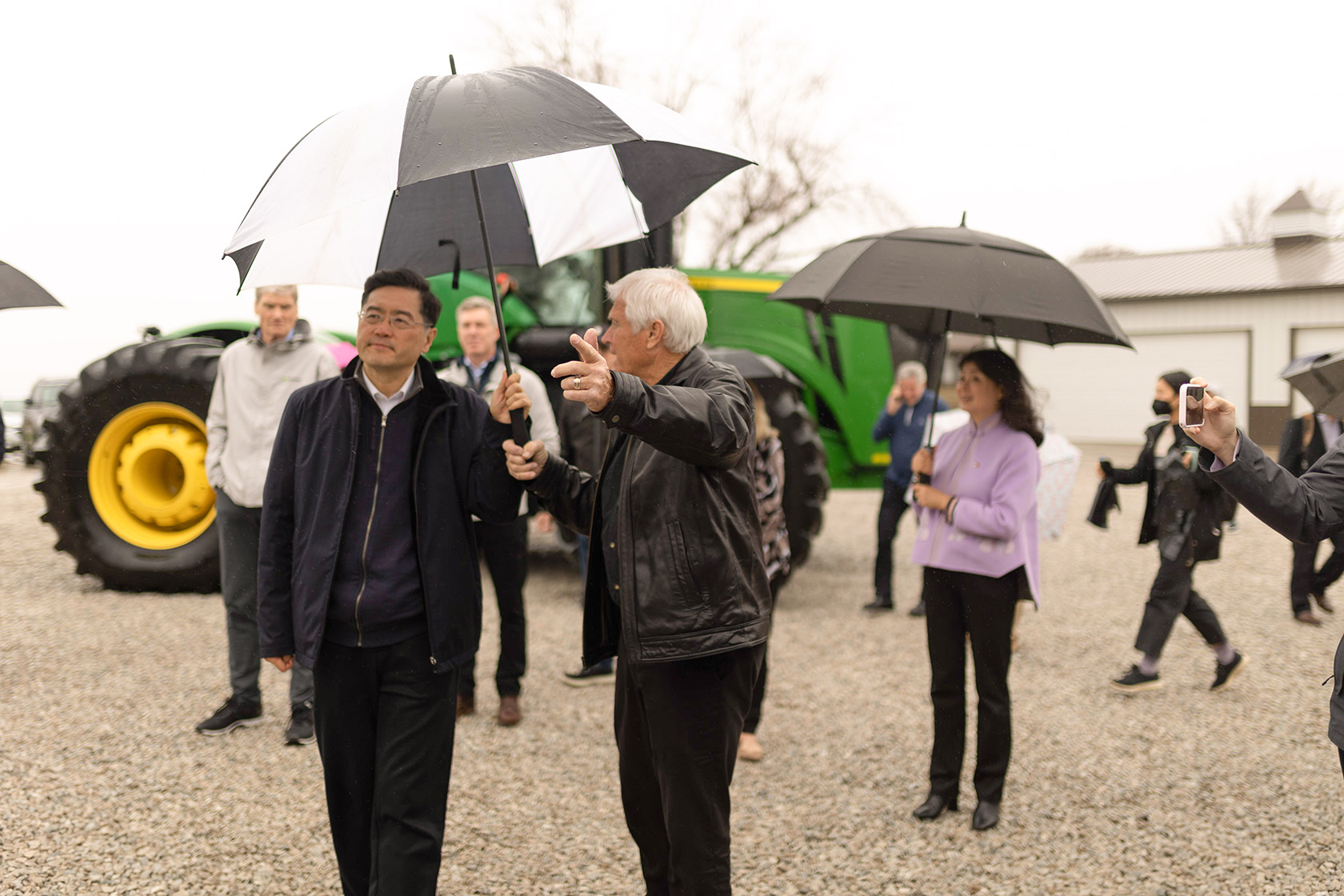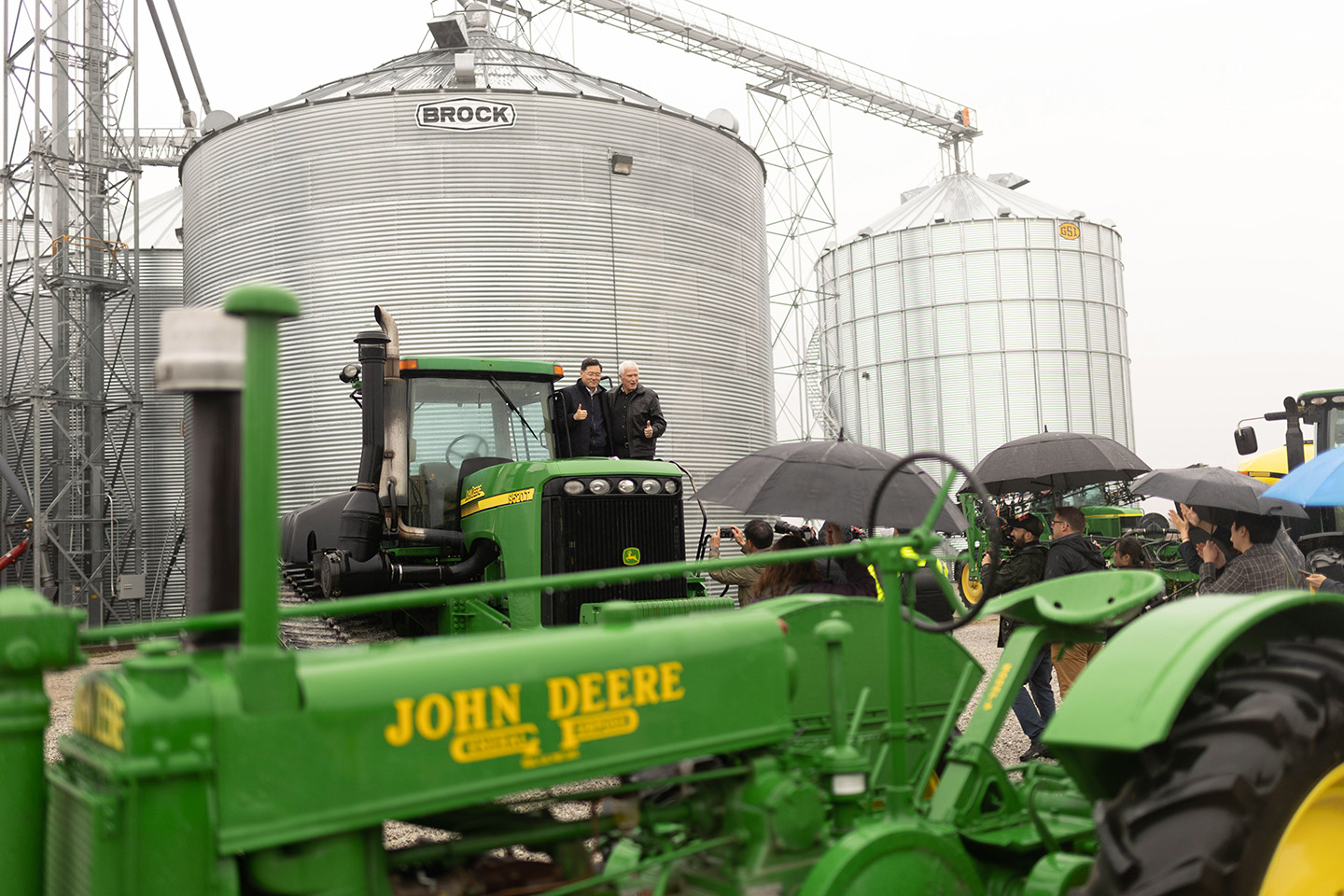
(Photo: Joclyn Bushman/Iowa Soybean Association)
Ambassador's visit stresses opportunity in expanding trade
May 26, 2022 | Bethany Baratta
Ten years after hosting then-Chinese Vice President Xi Jinping, the Kimberley family hosted Qin Gang, Chinese Ambassador to the U.S., on their farm near Maxwell.
It was part of the ambassador’s visit to the U.S. with his wife and others, exploring cooperation opportunities and learning about the advanced technology used on the farm.
“We want to tell you how pleased and happy we are to have you here today in our home,” says Rick Kimberley, greeting his guests.
The visit to the Kimberley farm followed the U.S.-China High-Level Agricultural Dialogue, which took place the night before at the World Food Prize Hall of Laureates in Des Moines. A focus of the event was the relationship between Iowa farmers and Chinese consumers. The visit to the Kimberley farm was an extension of that discussion between the largest global purchaser of soy (China) and a top supplier of U.S.-grown soy (Iowa farmers).
Finding efficiencies
The Kimberleys roots in America date back to the 1860s when they emigrated from England. Rick and Martha farm with their son, Grant, senior director of market development for the Iowa Soybean Association (ISA) and executive director of the Iowa Biodiesel Board.
Efficiencies have improved since the 1800s. Several generations later, the Kimberley family has traded in the horses typically seen on an Iowa farm for 600-horsepower tractors.
All the while, they’ve managed the risks: weather, financial, environmental and technology.
“It’s not easy,” says Rick Kimberley, an ISA farmer member. “You have to be able to adjust and adapt.”
They’ve grown soybean production from 25 bushels per acre in the 1970s to 75 bushels per acre in 2021. During the same period, corn yields have improved from 125 bushels to 250 bushels per acre.
“China is an important partner with us in agriculture – a very large buyer of soybeans and corn, and it’s really important for us that we can continue to grow significant crops,” Kimberley says. “But we have to do it in a safe, secure and sustainable manner.”
The Kimberleys are frequent travelers to China, traveling more than 20 times to visit the country’s farmers. They also work in the Hebei province on a demonstration farm to showcase modern farming techniques modeled after their family farm. Iowa and Hebei, China, have had a sister-state relationship since 1983.
The 45-minute conversation in the living room of the Kimberley’s ranch-style home bounced between a discussion about grain storage, the Ukraine-Russia war and its impact on global agriculture, how farmers determine what they’ll plant from year to year, and how the Chinese buyers and U.S. farmers could benefit from increased trade. It culminated with a gift exchange, a sampling of Iowa foods in the Kimberley kitchen, and when the rain lifted, a tour of the farm and a ride in the tractor Xi drove during his 2012 visit.

Growth in demand
To become less reliant on global soybean suppliers, China’s leadership in 2019 set a goal to produce about 23 million metric tons of soybeans by the end of 2025, up 40% from recent production of 16.4 million metric tons. However, soybean production in 2021 fell 16% from 2020 as markets favored corn production, and farmers responded by planting more corn over soybeans. Thus, imports of soybeans increased.
Due to limited land availability and a growing population, China grows 15 to 20% of its total need annually for food and feed. The rest, more than 80%, is imported from the U.S. and other global sources. U.S. soybeans accounted for about 37% of China’s soybean imports between September 2020 and March 2021 (marketing year 2020/21).
China’s purchases of soybeans grew in marketing year 2021/22 (September 2021 to March 2022), according to the latest data from the U.S. Department of Agriculture (USDA). Year-to-date information shows China imported 49.7 million metric tons from all sources, 48% of which were sourced from the U.S.
China is expected to import 99 million metric tons in marketing year 2022/23, according to the USDA’s May World Agricultural Supply and Demand Estimates (WASDE) report.
“China is the largest buyer of soy in the world, so they need to have multiple sources,” says Jim Sutter, CEO of the U.S. Soybean Export Council. “But they count on the U.S. because of our reliability, quality, and, in an increasing way, the sustainability because that’s becoming more important.”
The potential for further cooperation and trade between China and the U.S. is immense, Gang and Kimberley agree.
“The U.S. and China are the world leaders, and we need to take that to heart – not just to say it,” Kimberley says. “If our two countries can come together, the rest of the world can come together.”
Increased cooperation and trade between the countries will ultimately improve profits for American farmers, aid in meeting the needs of Chinese consumers and support global food supply stability, Gang and Kimberley assert.
“We are facing many uncertainties globally … but China will continue to buy more U.S. agriculture products,” Gang says. “This is the foundation.”
Back